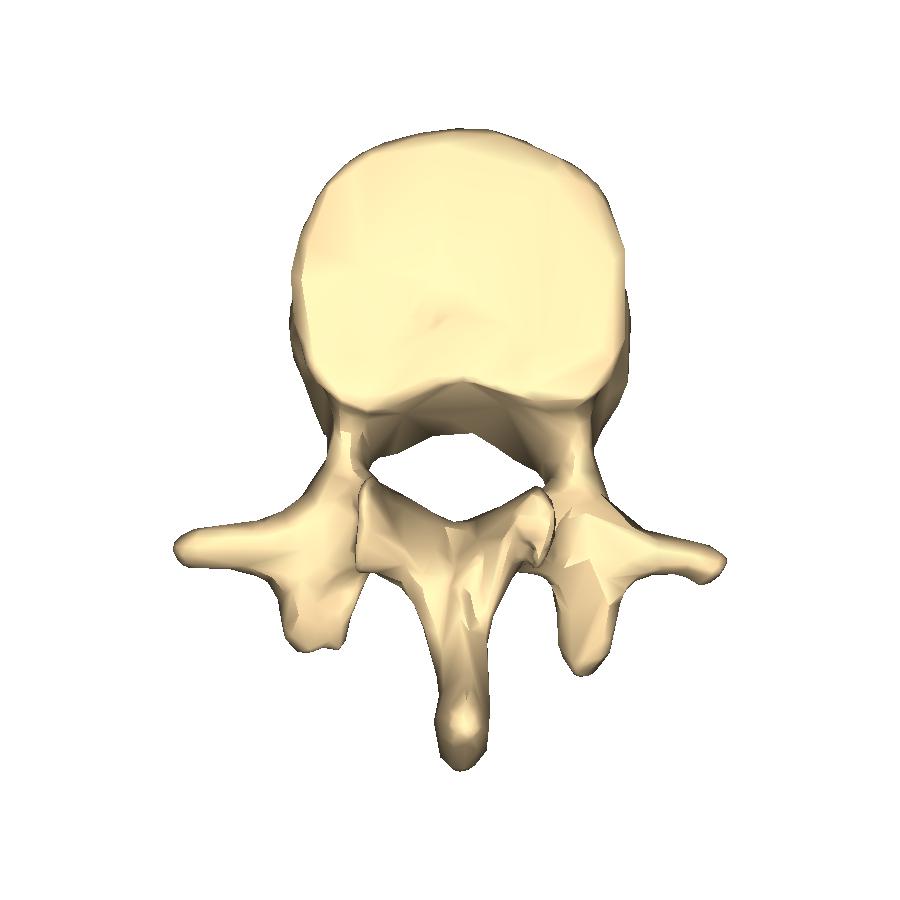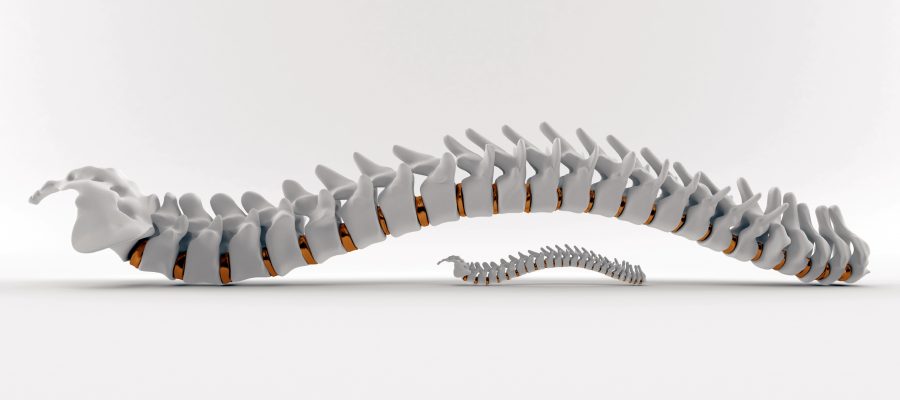The spine is the main axis to which almost all internal organs in the human body are attached. Its constituent parts are the vertebrae, the structure and functions of which are different in each department. The total number of human vertebrae reaches thirty-four.
Anatomy
The human spine includes 5 different departments in function and structure, each of which differs in the number of vertebrae:

- The upper section relative to the head is cervical. It consists of seven vertebrae, of which four are typical and three are atypical, their coding is C1 - C7. The name comes from the word cervix - "neck" (lat.).
- The next spine in vertebrates is the thoracic. It has 12 vertebrae. Atypical is the last one. The medical coding for this spine is Th1 - Th. Descended from thorax - "chest" (lat.);
- Below the chest is the lumbar region. The spine in this place consists of five typical parts, the medical coding is L1 - L. It is true for this department of origin of the name from the name of the Latin department - lumbalis - "lumbar".
- Next comes the sacral bone, which is the sacral spine. Its difference from all departments located above is that it is represented by five fused components - vertebrae, separated by transverse lines. In humans, this bone has a triangular shape, connected to the pelvic bones and tailbone. Medical terminology for the names of the vertebrae that form the sacrum is S1 - S. From the word sacrum - "sacrum". The joint sacral bone in Latin is called os sacrum.
- The last and lowest spine relative to the ground is called coccygeal. It is tightly bound to the sacrum. The spine in the coccygeal section may consist of four or five vertebrae. The medical encoding - Co1 - Co, came from the name of the bird, the shape of the beak of which it resembles - coccyx. The name of the single bone is os coccygis.
The spine is a column vertically located in the human body. From here came the name Columna Vertebralis, which determined the spine - the spinal column. The vertebrae are interconnected by intervertebral discs. Between the anatomical formations of the vertebrae there is a large number of ligaments, cartilage and joints, which provides flexibility and mobility of the vertebrae among themselves. The most mobile department is the cervical. The least mobile part of the spine is the lumbosacral. Bends called lordoses and kyphoses are also included in the structure of the spine.
The origin of vertebrates
In the process of phylogenesis, vertebrates evolved from the simplest chordates. The backbone in the animal kingdom came from the chord, a long longitudinal dorsal cord that is often present in the individual development of each of the existing vertebrate species at some stages of fetal development. In addition to humans, the class of vertebrates includes fish, birds, reptiles, amphibians and mammals.
Spine in embryonic development
The spine is an organ that, in the process of embryonic development, is formed in the second week from the primary germinal sheet, the ectoderm. The spine at the beginning of development is represented by cartilage. The initially formed chord, after enveloping the bone tissue of the vertebrae, remains between them in the intervertebral discs. By the end of the second month of pregnancy, ossification of the vertebrae occurs.
Spinal function
The spine is an organ that provides the body with many functions. The main functions of the spine include supporting, protective, cushioning and motor.
Motor function of the spine
In addition to the fact that the pelvic bones are attached to the spine, on which the legs are attached, providing the general mobility of the human body in space, the spine also provides mobility of the body in different planes. The movement becomes possible due to the ligamentous-articular apparatus of the vertebrae and processes. As for mobility, the cervical and lumbar spine are the most mobile, the thoracic is less mobile due to the ribs attached to it, and the sacral and coccygeal are completely immobile. The muscles of the spine provide many muscles that attach to different processes of the vertebrae. In determining the mobility of the spine, the main role is played by the state of the intervertebral discs.
Protective function
The spine is a dense, bone membrane, which serves as a protective function for the main source of transmission of nerve impulses in the human body - the spinal cord. To protect it, in the process of phylogenesis three different shells took shape - hard, arachnoid and soft, located one below the other and forming a system of spaces. Also from the spinal cord departs from 31 to 33 nerves that innervate one or another part of the body. Damage to the spinal cord can lead to many complications, up to paralysis.
Support and depreciation of the spine
When moving, a person rests on his legs, and the spine is attached to the legs through the pelvic bones. In humans, due to the vertical way of movement, the maximum load goes precisely to the spine, to which many organs are attached through fascia and muscles. You can trace a consistent increase in the size of the vertebrae from top to bottom. Due to the high load on the pelvic bones, it is the bones of the lumbar spine that are distinguished by the greatest size and strength. The first and second cervical vertebrae - the atlas and epistrophy, to which the skull is attached, and many ligaments to hold it in a normal position also differ in relatively large size.
Depreciation function. It lies in the fact that during movement, the load on the spine is reduced due to vibration acting on the back. Depreciation function is performed due to the many muscles around the spine, preventing the vertebrae from moving among themselves. However, it is possible inflammation of the muscle fiber, due to extreme stress on the muscles. The articular and ligamentous apparatus of the spine also help in the work of this function.
Muscular apparatus of the spine
Around each vertebra, many muscles are attached, called the paravertebral. In their work, they hold the vertebrae in their place, allow conscious body movements back and forth. They are attached to the natural processes of the vertebra. Strong loads of the paravertebral muscles lead to their stretching - myasitis, and the impossibility of the correct functioning of this muscle. In addition, around the vertebra there is the longest muscle of the back - the longissimus, which by its function is pulling, and it is she who is responsible for giving the spine a direct shape, attaching from the pelvic bones to the base of the skull.
Spinal injury
The spine is a part of the body that is often exposed to injuries. A spinal injury is called damage to the component parts that form and give mobility to the spinal column, received in one form or another. They arise due to mechanical damage to the body. Injuries to the spine and back often lead to disability, if the spinal cord is affected. In addition, if the latter is damaged, death is possible due to pain shock or injuries received.
Spinal Injury Factors
Injuries to such a protected part of the body are possible only if significant force is applied to this part of the body. Damage to the spine can be caused, for example, by road traffic injuries, strong blows during sparring in sports, and falls from high heights. In the presence of pathological changes in the back, spinal injuries due to falling from a small height, sudden movement are possible.
Types of spinal injuries
Spinal injuries are distinguished into open and closed. If the injury is received with an open wound, it is called open, with closed damage - closed. By type of spinal injury are classified into:
- Injuries to parts of the human ridge. There are with and without hematomas.
- Stretching of the ligamentous apparatus of the spine.
- Fractures or cracks in any part of the vertebra (body or arch of the vertebra, spinous and transverse processes).
- Complete and incomplete dislocations of the vertebrae.
According to the danger for later life, spinal injuries are divided into stable - not leading to further deformation and unstable - leading to continued deformation.
Spinal injuries are also classified according to the effect on the spinal cord - on reversible and irreversible. They also include spinal cord compressions obtained as a result of edema or hematoma of this spine.
Treatment of the spine, symptoms
To establish a diagnosis, the attending physician must send the patient to the x-ray in two planes to determine the axis of the spine. Depending on the diagnosis, the doctor will prescribe specific methods of therapy. The doctor also pays special attention to the symptoms that made the patient come to the appointment.
With spinal injuries , a person feels severe pain. Due to the very high number of nerve roots, any injury to the spine leads to the fact that a person experiences enormous pain, which can radiate to many parts of the body. When trying to move, very sharp pains are often possible. When stretching, difficulties arise in movements, sharp pain, touch give the person suffering. In the case of fractures of parts of the components of the spine, the patient most often complains of spilled pain. With dislocations and subluxations, the rotational movements of the human body are difficult, and pain also occurs. Symptoms of spinal cord injury vary greatly depending on the location of the damage.

With minor injuries of the spine, the patient can be prescribed bed rest for up to two months with the use of pain medications if necessary. Treatment may require massage and thermal treatments. Medium and severe spinal injuries result in the patient being placed in a hospital ward for therapy. In this case, often the patient is fixed in a fixed position, if necessary, adjusting parts of the vertebrae before immobilization. Surgical intervention is necessary for damage to the spinal cord or with ongoing compression. If traditional treatment fails, a referral to a planned operation for the reconstruction of injured segments of the back is possible.
Measures to recover from an injury include a diet rich in vitamins and minerals, foods containing calcium and iron, and general restoratives.